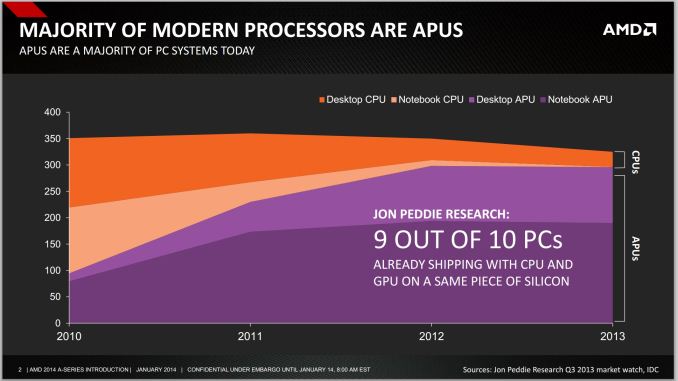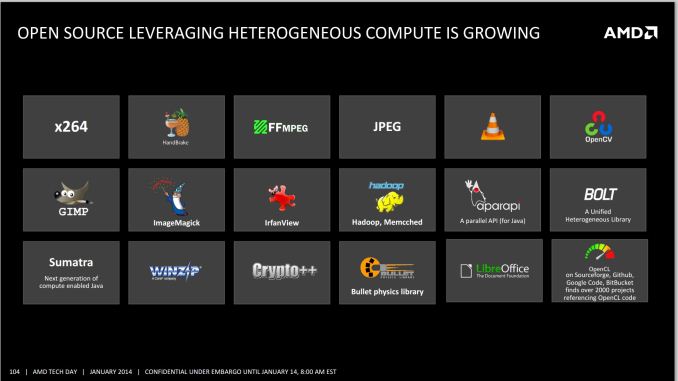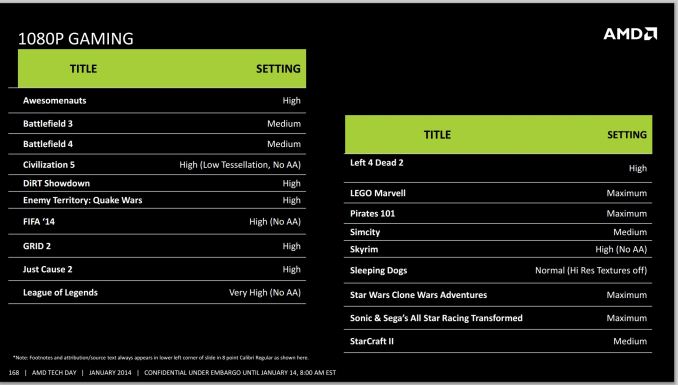AMD Kaveri Review: A8-7600 and A10-7850K Tested
by Ian Cutress & Rahul Garg on January 14, 2014 8:00 AM ESTKaveri: Aiming for 1080p30 and Compute
The numerical differences between Kaveri and Richland are easy enough to rattle off – later in the review we will be discussing these in depth – but at a high level AMD is aiming for a middle ground between the desktop model (CPU + discrete graphics) and Apple’s Mac Pro dream (offloading compute onto different discrete graphics cards) by doing the dream on a single processor. At AMD’s Kaveri tech day the following graph was thrown in front of journalists worldwide:
With Intel now on board, processor graphics is a big deal. You can argue whether or not AMD should continue to use the acronym APU instead of SoC, but the fact remains that it's tough to buy a CPU without an integrated GPU.
In the absence of vertical integration, software optimization always trails hardware availability. If you look at 2011 as the crossover year when APUs/SoCs took over the market, it's not much of a surprise that we haven't seen aggressive moves by software developers to truly leverage GPU compute. Part of the problem has been programming model, which AMD hopes to address with Kaveri and HSA. Kaveri enables a full heterogeneous unified memory architecture (hUMA), such that the integrated graphics topology can access the full breadth of memory that the CPU can, putting a 32GB enabled compute device into the hands of developers.
One of the complexities of compute is also time: getting the CPU and GPU to communicate to each other without HSA and hUMA requires an amount of overhead that is not trivial. For compute, this comes in the form of allowing the CPU and GPU to work on the same data set at the same time, effectively opening up all the compute to the same task without asynchronous calls to memory copies and expensive memory checks for coherency.
The issue AMD has with their HSA ecosystem is the need for developers to jump on board. The analogy oft cited is that on Day 1, iOS had very few apps, yet today has millions. Perhaps a small equivocation fallacy comes in here – Apple is able to manage their OS and system in its entirety, whereas AMD has to compete in the same space as non-HSA enabled products and lacks the control. Nevertheless, AMD is attempting to integrate programming tools for HSA (and OpenCL 2.0) as seamlessly as possible to all modern platforms via a HSA Instruction Layer (HSAIL). The goal is for programming languages like Java, C++ and C++ AMP, as well as common acceleration API libraries and toolkits to provide these features at little or no coding cost. This is something our resident compute guru Rahul will be looking at in further detail later on in the review.
On the gaming side, 30 FPS has been a goal for AMD’s integrated graphics solutions for a couple of generations now.
Arguably we could say that any game should be able to do 30 FPS if we turn down the settings far enough, but AMD has put at least one restriction on that: resolution. 1080p is a lofty goal to hold at 30 FPS with some of the more challenging titles of today. In our testing in this review, it was clear that users had a choice – start with a high resolution and turn the settings down, or keep the settings on medium-high and adjust the resolution. Games like BF4 and Crysis 3 are going to tax any graphics card, especially when additional DirectX 11 features come in to play (ambient occlusion, depth of field, global illumination, and bilateral filtering are some that AMD mention).













380 Comments
View All Comments
takeship - Tuesday, January 14, 2014 - link
Also, any chance that power consumption numbers are going to be added to this review? Looking around the rest of the internet, it would appear than AMD's idea of 45W/65W don't really jive with the actual consumption figures. I.e. their 45W chip is actually pulling closer to 80W under load, and doesn't make them even perf/watt comparable with an i3.silverblue - Tuesday, January 14, 2014 - link
I saw similar figures, but that was for the system as a whole.Traciatim - Wednesday, January 15, 2014 - link
Keep in mind that measuring 80 watts from the wall through an 80% efficient supply has the whole machine consuming 64 watts.aryonoco - Tuesday, January 14, 2014 - link
"...do any AnandTech readers have an interest in an even higher end APU with substantially more graphics horsepower?"Definitely yes, for a low-end steam machine for casual gaming in the living room.
The only way to hit the $400 price for a steam machine is to forgo the dedicated graphics card and use an APU/SoC. But none of these Kaveri SKUs, even the highest end A10 one, would cut it. I do not expect such an APU to beat $200 dedicated cards, but it needs more performance than this.
If AMD could offer a Kaveri APU with say 30% more GPU power and the same CPU power, for around $200, I think it would be a very attractive option for a steam machine.
Of course that would require AMD to finally start making respectable Linux drivers as well... which probably means it won't happen.
Nagorak - Wednesday, January 15, 2014 - link
I'd wait and see if the Steam OS even goes anywhere. Odds are strongly against it.nemesis1985 - Tuesday, January 14, 2014 - link
1680x1050A10-7850 = company of heroes --- sleeping dogs --- f1 2013
fps ====== 35 ======= 21 ====== 38 =
A10-7600 = company of heroes --- sleeping dogs --- f1 2013
fps ====== 61 ======= 52 ====== 42 =
1920x1080 = same (problem)
and says kaveri have only 2 cores
or its just a misunderstanding by me
http://images.anandtech.com/doci/7677/G2%20-%20100...
http://images.anandtech.com/doci/7677/G9%20-%2045W...
whats wrong with this bench
nemesis1985 - Tuesday, January 14, 2014 - link
beomagi -Nevermind - I now see this is as a percent difference compared to the slower chip - the title said FPS and that threw me off.
Ignore! :D
yeah me too :D
nemesis1985 - Tuesday, January 14, 2014 - link
misunderstanding (very sorry) please delete my commentkwrzesien - Tuesday, January 14, 2014 - link
Pretty disappointing.And what's the point of testing 1080p gaming at top settings? Does it even matter who is better when below 15 fps? Why not find a setting for each game in 1080p where at least one solution is over 30 fps average - that might show something interesting.
mavromanitari - Tuesday, January 14, 2014 - link
Anandtech Logic:Let's match up a 170$ amd APU vs the intel IGP flagship (4770R) that costs 392$...
Nah still beats it at high resolutions, we need to do more! Oh well lets put the 320$ 4770K and throw 100$ on a dGPU...
We have done it!! Yay the 420$ combination beats the 170$ APU....